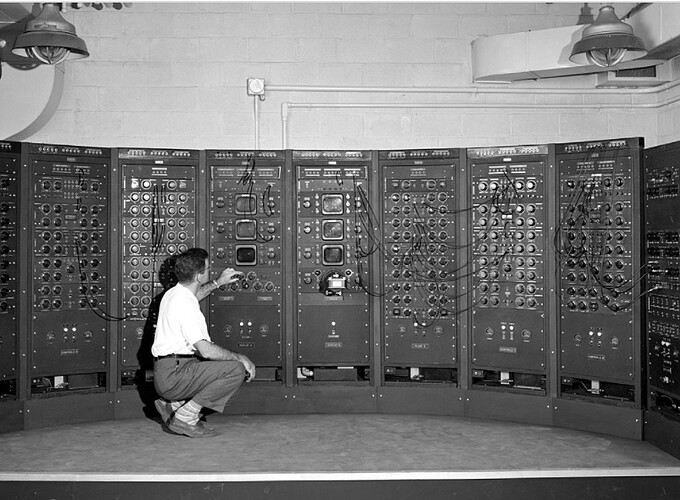-
Why must computer designers and software engineers use binary math?
-
In what way does the answer to question 1 separate computers from brains?
_
Et silence… de tout le monde.
Pour l’instant.
_
You guys’ most active time, is my beddy-byes-definitely-gotta-crash time…
heck
yo these are trick questions
there are multiple answers
can you specify
what’s the angle of approach here?
OK look. We already established the reason computer designers and software engineers rely on binary math. It’s because the basic level of mechanical manipulation in computers that activates whatever dependent mechanisms are attached to a given computer consists of transistors that either allow electricity through or not. That is all they do. This allows computer designers and software engineers to manipulate them using code that substitutes “allows electricity through” for “1” and “does not allow electricity through” for “0.”
Now, question 2 is in what way this separates computers from brains.
well that is not really an answer “because they’re made of transistors”, is it?
they’re built by men
why not build them with circuits that can represent base 10?
pop quiz back at ya bitches
Well how would you do that? Other than by making groups of ten transistors, and basically just using the same technology?
Like, how would you provide more than 2 options at the bit level?
By the way I’m not saying there is a single answer to question 2. I am just discarding answers that are hazy or don’t accurately reflect the mechanisms in brains or may represent differences between computers and brains but not regarding the answer to question 1.
ok in really simple terms
you could for example create a system that triggers a value upon hitting a certain voltage
but you run into a few problems
one is that you’d have to keep cranking up the power on them to arrive at different values
another one is interference, which causes, say 1 volt to mean anything between 0.75 and 1.25, give or take
which aggravates the power consumption issue
since you’d have to allow for a big gap between assigning values to voltage
to make up for that margin of error
and then you begin to realize how large and complicated and expensive these circuits would have to be
plus all the extra stuff required power them and to cool them down
so it comes down to practicality
simplifying the system to base 2 allows for a much simpler build
miniaturalization and cost reduction down to personal computers
also increases in precision
were only possible due to the binary system
btw analogue computers did exist for a while
but these limitations retired them
they used to look like this
OK, that’s actually pretty cool, but OK, even if theoretically it is possible, no computers that go beyond binary exist, because of the mechanisms we described, which aren’t the only possible ones but are the only existing ones. And some of the reasons they are not practical might become interesting later on.
But fine, the original answer to question 1 remains pretty much the same.
The question, about the mechanisms of computers, has been answered.
no sir
the answer is not that they are made of transistors
if we could make machines that are simpler, smaller, cheaper, and more precise by means of a component other than transistors, we would do so
the answer is because binary systems are simpler, smaller, cheaper, and more precise
Agree… but they still happen to be made using transistors.
I recall an alternative being in the works…
Do all computers use transistors yes or no and is binary code in all cases used to manipulate them yes or no?
yeah but do you understand the difference in my answer?
to say they are made of transistors answers a “how” question, not a “why”
the use of one vs the other is the means to an end
the end is efficiency
Agree… but they still happen to be made using transistors.
I recall an alternative being in the works…
people have been talking about quantum computing for ages
Well it’s a “why” question if you look at it from the point of view of the actual computer, of the actual technology. The why is absolutely transistors.
